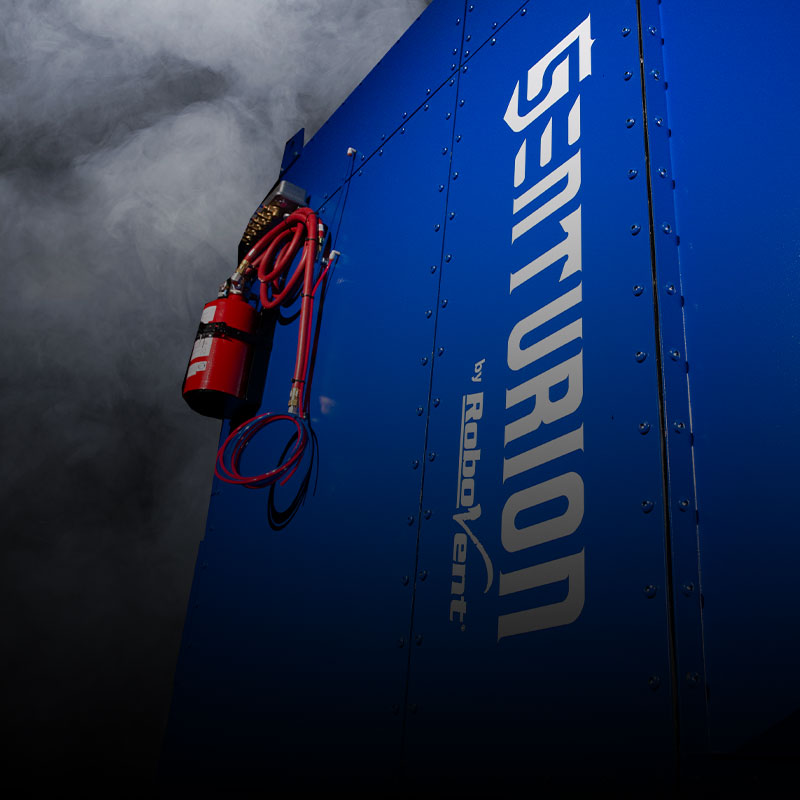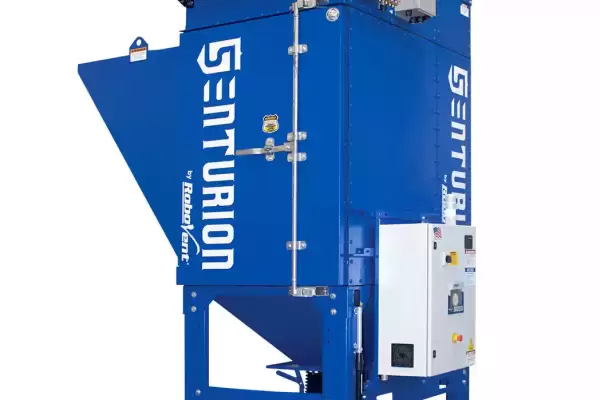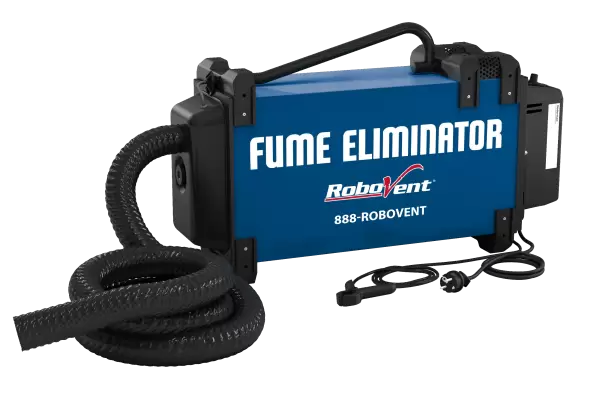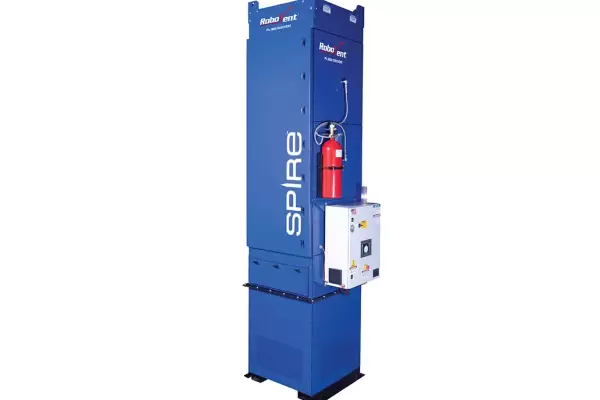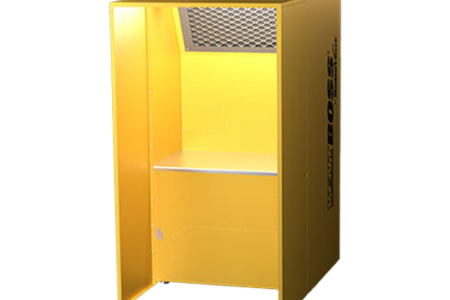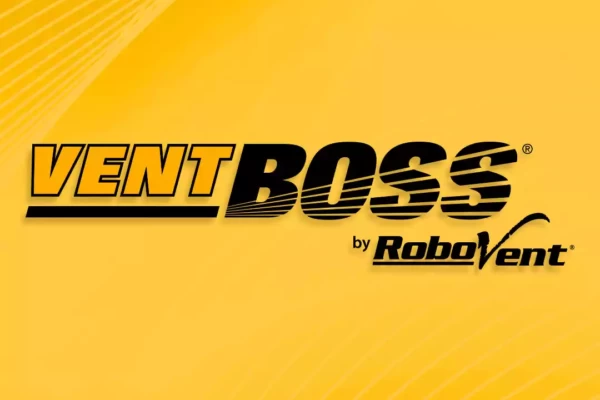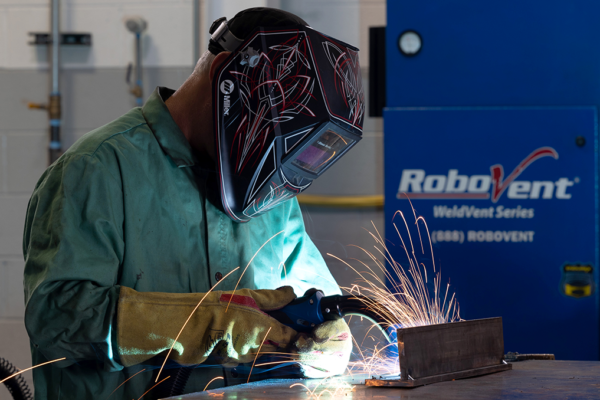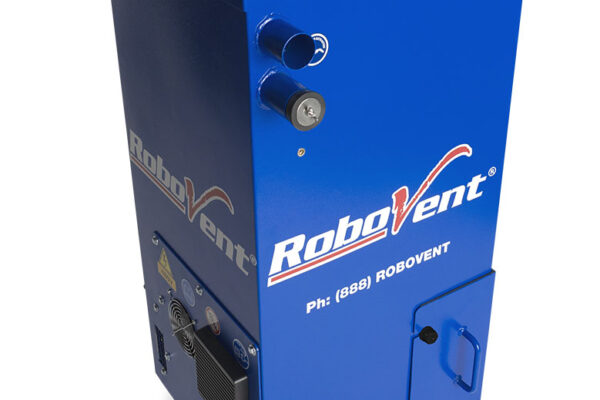SOLUTIONS FOR MIG, TIG AND STICK WELD FUME EXTRACTION
Get tough on MIG, TIG, Stick and Flux-Cored welding emissions with robust, flexible source capture and ambient air filtration solutions from RoboVent. Whether you need a powerful whole-facility solution like RoboVent Senturion, a small portable dust collector like ProCube II, Fume Eliminator™, or a space-saving dust collector like RoboVent Spire, we’ve got you covered. We can help you:
- Analyze your indoor air quality and determine your exposure risks.
- Design a weld fume extraction solution tailored to your processes, your facility, and the needs of your welders.
- Ensure that your facility is compliant with OSHA PELs for weld fume exposure.
- Create a safe, healthy and comfortable environment for welders.
Welding Types and Emission Risks
Different types of welding have different emission risks depending on the materials used. For many types of welding, the majority of emissions–up to 95%–come from the consumables used to create the welding arc. There are several different welding processes that use a consumable welding rod or welding wire, including MIG (GMAW), Stick (SMAW), Flux-Cored (FCAW), and (sometimes) TIG. In arc welding processes, the welding wire or rod acts as an electrode. As the electrode is fed through the weld torch, it creates an electric arc, which generates the heat to create the join. Part of the metal consumable becomes filler in the weld seam, but a lot of the material is vaporized. These types of welding produce significantly more weld fume than resistance welding or laser welding, which do not use consumables.
Weld Fume Composition for MIG, Stick or Flux-Cored Welding
The volume and composition of weld fumes for arc welding processes depend on the welding process and the base materials and consumables used. Weld fumes are a complex mix of oxidized and unoxidized metals and other elements, including iron, lead, cobalt, cadmium, manganese, aluminum, nickel, potassium, silicon and zinc. Weld fumes also contain gases such as argon, carbon dioxide or carbon monoxide. It may contain volatile organic compounds (VOCs) and other substances created when lubricants or coatings are burned or sublimated during welding. About 95% of weld fumes from arc welding come from the welding wire or rod.
Health Risks of MIG, Stick and Flux-Cored Welding
Exposure to weld fumes from MIG, Stick, FCAW or TIG welding can create serious health problems, which may be acute or chronic. Acute symptoms of weld fume exposure include irritation to the throat, eyes, nose and lungs and a dangerous condition known as “metal fume fever”, a flu-like illness caused by exposure to zinc or zinc oxides. Welders exhibiting symptoms of metal fume fever or acute respiratory distress should be removed to an area with fresh air immediately and seek medical attention as soon as possible. Long-term exposure to weld fumes is associated with other risks including cancer, neurological disorders, lung damage and kidney disease.
Industrial Regulations for Arc Welding
MIG, stick, FCAW and TIG welding produce dangerous and toxic elements that are regulated by the Occupational Safety and Health Administration (OSHA) in the US and by other regulatory agencies across the globe. The OSHA Permissible Exposure Limit (PEL) for total weld fume concentration is 5 mg/m3 when welding mild steel, iron or aluminum. However, OSHA also sets PELs for specific elements and compounds found in weld fumes, which are often much lower. These are expressed as Permissible Exposure Limits (PELs), which are measured and averaged over a worker’s 8-hour shift. For some highly toxic substances, OSHA also sets a separate action limit; exposures above this limit may require specific compliance activities such as blood testing. Failure to control dust in areas where workers may be exposed can result in serious fines and legal action.
Considerations in Fume and Emission Control for Arc Welding
When designing a weld fume collection system for MIG/GMAW, TIG/GTAW, stick/SMAW, or Flux-Cored/FCAW welding processes, the most important consideration is minimizing human exposure. The system must be designed to reduce exposure to toxic elements in weld fumes below OSHA PELs. Manufacturers may want to consider aiming for more stringent limits on weld fume exposure developed by ACGIH or NIOSH. Consider:
- Is the welding process manual or robotic?
- What is the volume of fumes produced?
- What is the composition of the weld fume?
- Where are humans exposed to welding fumes?
RECOMMENDED SOLUTIONS
OTHER SOLUTIONS
TOTAL FILTRATION PARTNER
RoboVent is your full turnkey resource for clean air in industrial environments. From facility testing and engineering, to installing equipment, providing replacement filters and preventive maintenance, RoboVent is ready to manage the whole process.
CONTACT US
Contact one of our industrial dust experts to gain the advantage against dust-generating processes and applications.


